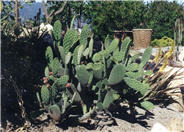
Common name:Mission Fig
Botanical name:Opuntia ficus-indica
This Opuntia is more tree-like than other types; it grows to15' tall. It usually has no spines but some glochids can be found. Flowers are yellow to orange in late spring and early summer. Fruit is edible. It does best in full sun and is frost sensitive. It needs well drained soil. The major pest and source of the red dye cochineal comes from a scale.
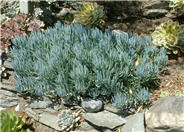
Common name:Kleinia
Botanical name:Senecio mandraliscae
This succulent perennial will grow to about 1.5' tall and 2' wide. It has curved, bluish gray leaves that are about 3.5" long and very slender.
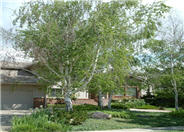
Common name:White Birch, European White Birch
Botanical name:Betula pendula
This medium-size weeping tree will grow to about 40' tall and has a whitish/brown bark with deciduous green leaves.

Common name:Lily of the Nile
Botanical name:Agapanthus praecox ssp. orientalis
This evergreen groundcover/shrub will grow about 3' tall and has large green leaves with blue flowers ( there is also a white variety) that bloom in spring and summer. It will grow in all soils but prefers loam soil.
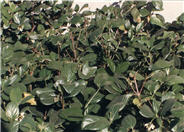
Common name:Sandankwa Viburnum
Botanical name:Viburnum suspensum
This broad-spreading evergreen produces dense, glossy foliage that is 4" long and oval in shape. Open, loose clusters of white flowers with a rose tint bloom in spring and summer. This shrub serves as a good specimen, hedge, or screen. This variety should be grown under sun or partial shade.
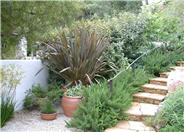
Common name:Red New Zealand Flax
Botanical name:Phormium 'Rubrum'
New Zealand Flax is an excellent accent plant for the garden. Evergreen leaves are long, narrow, and grow upright. Clusters of flowers grow on spikes above the foliage in late spring and summer. 'Rubrum' is a large, bold plant with stiff, vertical, strap-like leaves that arise from its base and are dark purplish red in color. It should be grown in full sun.
| Designer: | Western Back Gate |
Photographer: GardenSoft |
Soils and Compost:
Incorporate compost 6" into your soil to retain water, reduce compaction, feed earthworms, and provide valuable nutrients to your plants.
Water Saving Tip:
Apply a layer of mulch around plants to reduce moisture loss.
Choose organic mulches, such as shredded bark, compost or aged sawdust.
Integrated Pest Management:
Attract, or buy beneficial insects such as ladybugs and lacewings to control pest outbreaks in your garden.

